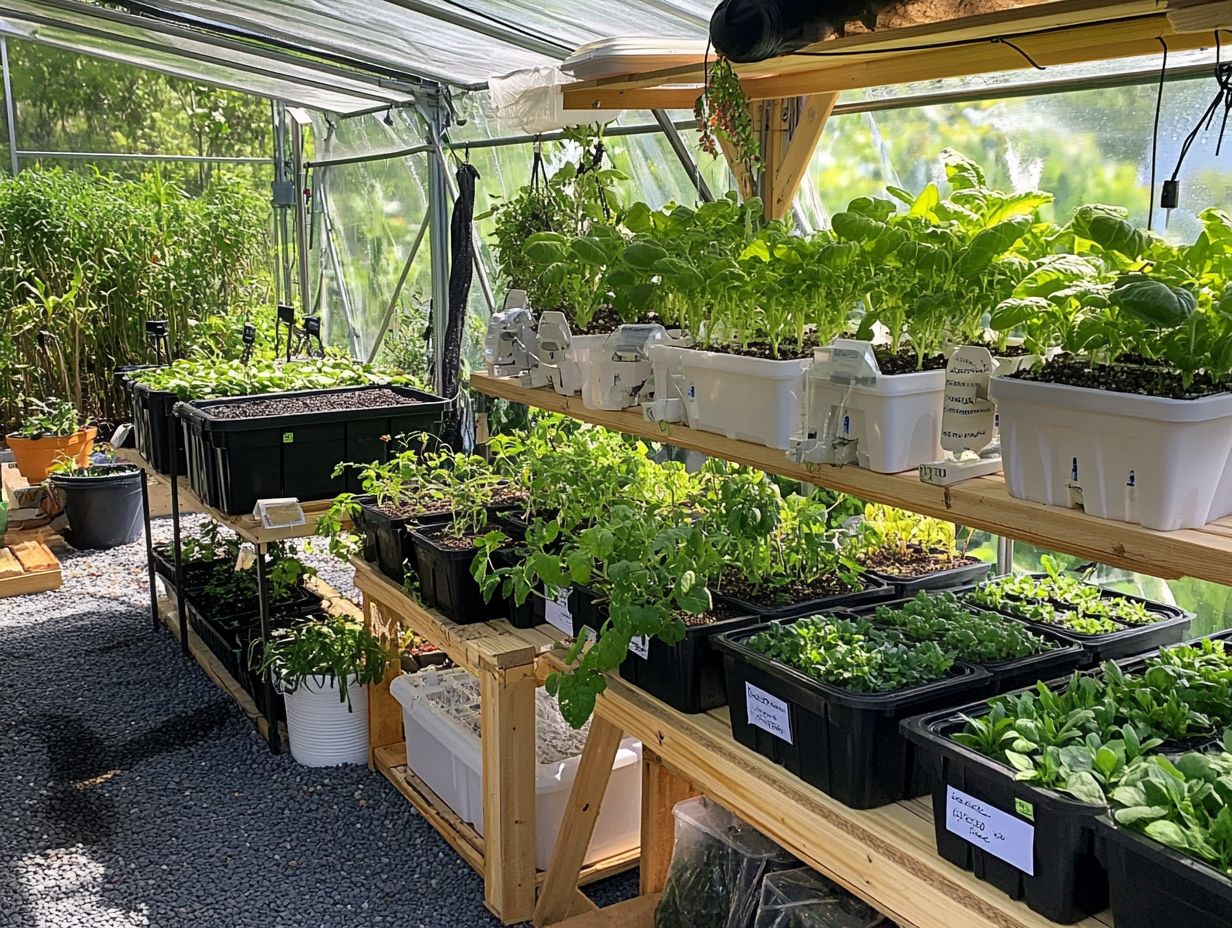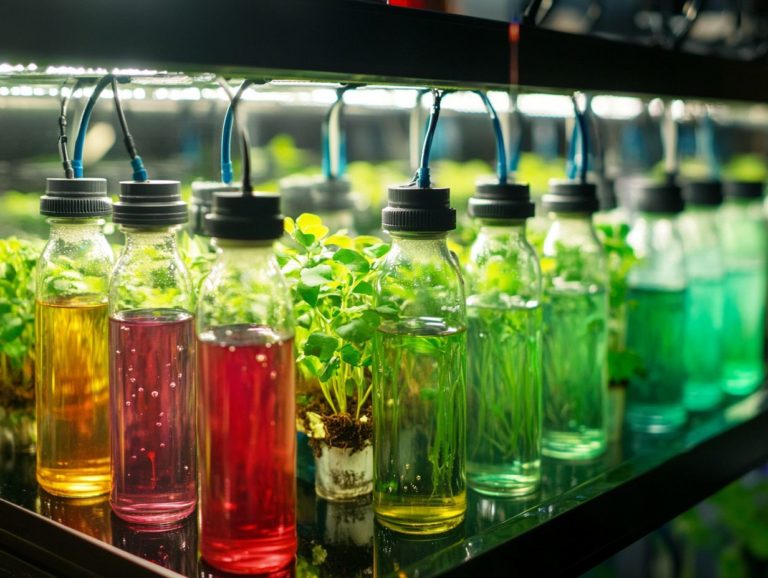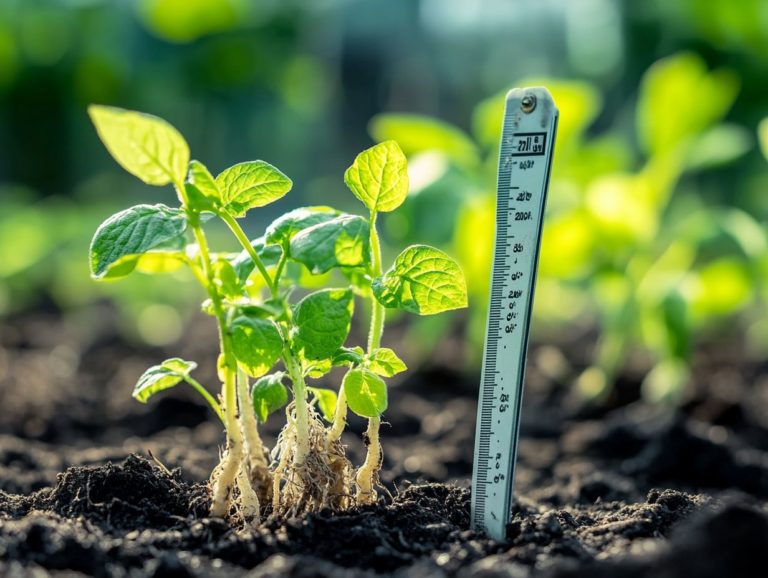Using Nutrient Solutions in Different Growing Systems
Nutrient solutions are critical for maximizing plant growth and ensuring overall health. Whether you re a seasoned gardener or just beginning your journey, understanding these solutions can significantly enhance your cultivation efforts.
This article delves into the myriad benefits of nutrient solutions, highlighting how they mitigate the risk of deficiencies and foster vibrant plant life. It also explores various growing systems, such as hydroponics and aquaponics, offering practical tips on preparing and applying these nutrient-rich formulas while steering clear of common pitfalls.
Get ready to boost your gardening!
Contents
- Key Takeaways:
- Benefits of Using Nutrient Solutions
- Types of Growing Systems that Utilize Nutrient Solutions
- How to Prepare and Use Nutrient Solutions
- Common Mistakes to Avoid When Using Nutrient Solutions
- Frequently Asked Questions
- What are nutrient solutions?
- What are the benefits of using nutrient solutions in different growing systems?
- Can nutrient solutions be used in all types of growing systems?
- How do I choose the right nutrient solution for my growing system?
- How often should I change my nutrient solution?
- Are there any drawbacks to using nutrient solutions?
Key Takeaways:

- Nutrient solutions greatly benefit plant growth and health by providing necessary nutrients and reducing the risk of deficiencies.
- Hydroponics, aquaponics, and aeroponics are growing systems that utilize nutrient solutions to support plant growth in a controlled environment.
- When preparing and using nutrient solutions, creating the right nutrient balance and choosing the proper application method is important to avoid common mistakes like overfeeding or improper pH levels.
What are Nutrient Solutions?
Nutrient solutions are carefully crafted mixtures designed to provide essential big nutrients and small nutrients to your plants, especially in systems where you grow plants without soil. These solutions include important ingredients like nitrogen, phosphorus, and potassium. They also have trace elements like iron and zinc, all working together to support optimal plant growth and development.
By using nutrient solutions, you can create a controlled environment that enhances nutrient uptake and absorption. This leads to healthier crops and improved yields key for sustainable farming practices.
Hydro-Gardens plays a crucial role in refining these solutions, ensuring that every essential nutrient is perfectly balanced to prevent deficiencies that could stunt growth. A well-formulated nutrient solution means your plants can efficiently absorb these elements, which directly influences their health and productivity.
Maintaining nutrient balance is crucial, as it directly affects nutrient efficiency. By diligently monitoring and adjusting nutrient levels, you can quickly identify and tackle potential deficiencies before they escalate, ultimately safeguarding both your crop yield and quality.
Benefits of Using Nutrient Solutions
Utilizing nutrient solutions in hydroponic systems presents numerous benefits that enhance plant growth and improve overall crop health, ensuring that urban farming and controlled environment agriculture thrive.
These solutions maximize nutrient efficiency while minimizing waste, creating optimal growth conditions, enhancing nutrient absorption, and leading to higher crop yields.
This method of plant nutrition not only supports sustainable farming practices but also reduces reliance on agricultural chemicals, fostering a culture of resource conservation.
Increased Plant Growth and Health
The use of nutrient solutions can significantly enhance your plant growth and health, making them essential for hydroponic crops like tomatoes and lettuce. By providing a tailored nutrient mix that aligns with specific plant needs, you can boost nutrient uptake and promote robust crop development, ultimately increasing your yield. This precise nutrient delivery supports vigorous growth and fortifies your plants natural defenses against diseases and environmental stressors.
Different growth stages require customized nutrient recipes. For instance, nitrogen-rich solutions can energize leafy growth in your salad greens, while potassium plays a vital role in fruit development for your tomatoes. Ensuring nutrient stability means your plants receive a steady supply of essential elements, minimizing fluctuations that could slow growth.
As a result, crops like peppers and cucumbers will thrive under optimized nutrient conditions, showcasing the compelling advantages of well-crafted nutrient strategies in boosting your overall agricultural productivity.
Jump in now to take your gardening skills to the next level!
Reduced Risk of Nutrient Deficiencies
One of the standout benefits of using nutrient solutions is the reduced risk of nutrient deficiencies. These deficiencies can harm plant health and reduce yield.
By providing a well-balanced blend of essential nutrients needed in larger amounts and nutrients needed in smaller amounts, you ensure your plants get what they need for optimal growth and development.
Regular nutrient testing and timely adjustments help you maintain the perfect nutrient balance, steering clear of issues like nutrient burn (damage from excess nutrients) or toxicity (harmful levels of nutrients).
Implementing nutrient solutions not only replenishes crucial nutrients like nitrogen, phosphorus, and potassium but also allows you to quickly address any deficiencies. Monitoring nutrient concentration helps identify shifts in plant needs, enabling prompt adjustments for healthy and thriving plants.
This strategy for managing nutrients creates a vibrant growing environment, boosting both the quality and quantity of your yields!
Types of Growing Systems that Utilize Nutrient Solutions

Many growing systems use nutrient solutions to boost plant growth. Hydroponics, aquaponics, and aeroponics are among the most popular methods in controlled environment agriculture.
These systems are meticulously designed to deliver nutrient-rich water directly to the roots of your plants. This creates optimal conditions for growth while conserving water and facilitating efficient nutrient absorption.
Each method presents its own unique advantages and challenges. It s crucial for you to select the right system based on your specific agricultural aspirations.
Hydroponics
Hydroponics is a remarkable method of growing plants without soil, relying on nutrient solutions to deliver essential nutrients directly to the roots for peak growth. This groundbreaking approach not only boosts plant health but also enhances water efficiency, using about 90% less water than traditional soil-based farming.
With hydroponics, you can maintain controlled growing conditions, allowing you to manage factors like light, temperature, and moisture for the best growth.
This technique effectively meets critical nutrient requirements, ensuring your plants receive a balanced diet through customized nutrient recipes. Unlike conventional farming, where soil quality can fluctuate and nutrients may deplete, hydroponic solutions provide stability that promotes consistent crop yields.
Urban farming will greatly benefit from this method, creating opportunities to cultivate fresh produce in densely populated areas. This not only reduces food miles but also enhances local food distribution. As cities expand, leveraging the power of hydroponics can be crucial in achieving sustainable and resilient agricultural practices.
Aquaponics
Aquaponics is an integrated agricultural marvel, expertly blending hydroponics with aquaculture, enabling fish and plants to flourish together in a beautifully symbiotic environment. In this system, the waste produced by fish becomes a nutrient-rich source for the plants, while the plants diligently filter and purify the water for the fish.
This sustainable farming practice significantly reduces the need for synthetic fertilizers and enhances nutrient efficiency, making it a perfect choice for those who are environmentally conscious.
By harmonizing the needs of both aquatic life and crops, aquaponics creates a delicate nutrient balance that fosters optimal growth. It drastically minimizes water usage compared to traditional farming methods, as the irrigation water circulates continuously within the system.
This innovative approach not only boosts crop yield but also champions the conservation of valuable resources, positioning aquaponics as a vital component of sustainable agricultural practices that tackle the pressing challenges of global food security.
Aeroponics
Aeroponics is a groundbreaking way to grow plants. It suspends them in air and mists their roots with nutrient solutions, using less water than traditional methods. This technique offers an efficient way to deliver nutrients and oxygen to roots, making it a game changer for urban farming.
By using tailored nutrient ratios, you can maximize productivity even in small spaces. You can cultivate everything from leafy greens to aromatic herbs and fruiting plants, all while conserving water and minimizing the space needed for production.
The potential of aeroponics in urban farming is gaining recognition as a viable strategy for feeding growing populations with minimal environmental impact. Dive into this revolutionary technique now and watch your garden thrive!
How to Prepare and Use Nutrient Solutions
It’s important to prepare nutrient solutions carefully. This ensures your crops get the nutrients they need to grow well.
You can create your own solutions or choose convenient premade options designed for specific crops, like the Hydro-Gardens tomato formula.
The key is balancing large nutrients (like calcium and potassium) and small nutrients (like iron and zinc). Regular nutrient testing is essential to maintain the right concentrations.
Creating the Right Balance of Nutrients

Getting the right mix of nutrients in your solutions is key to healthy plant growth. You must measure large nutrients like nitrogen, phosphorus, and potassium, along with small nutrients like iron, manganese, and zinc.
Regular nutrient testing ensures your plants receive the optimal concentration for sustained growth. Without proper balance, plants may experience nutrient inefficiency, leading to poor yields.
Understanding the relationships among these nutrients allows for better crop management strategies, including sustainable farming practices that promote a productive agricultural environment.
Application Methods
The way you apply nutrient solutions is vital. Different methods can help meet your plants’ specific needs.
As you explore application techniques, you ll find that drip irrigation efficiently delivers nutrients while minimizing water waste.
Misting systems boost nutrient absorption through the process where plants absorb nutrients through their leaves, allowing for quick adjustments. Monitoring nutrient mixes is essential for achieving balanced growth.
By fine-tuning your approach, especially through effective nutrient replenishment, you can support photosynthesis and root development, leading to robust yields.
Common Mistakes to Avoid When Using Nutrient Solutions
When using nutrient solutions, avoiding common mistakes is crucial to ensure the health and yield of your hydroponic crops. Miscalculating nutrient concentrations, overlooking pH balance, or overfeeding your plants can lead to problems like nutrient deficiencies, nutrient burn, and even toxicity.
By recognizing these issues and applying best practices for effective use of nutrients, you can create a thriving environment for plant growth and pave the way for long-term success.
Overfeeding and Underfeeding
Overfeeding and underfeeding are common missteps you ll face as a grower. Both can seriously compromise plant health. Overfeeding may cause nutrient burn, where excess nutrients accumulate in the soil or solution, leading to root damage and poor plant performance.
On the flip side, underfeeding can cause nutrient deficiencies that stunt growth and productivity. Therefore, closely monitoring your nutrient application rates is essential.
To avoid these pitfalls, understand the importance of nutrient concentration and balance. Regular testing of soil or solution provides valuable insights into nutrient stability, allowing for timely adjustments. A well-crafted nutrient schedule tailored to your specific varieties can also help mitigate the risks of overfeeding and underfeeding.
Keep a close watch for signs of nutrient excess or deficiency, such as yellowing leaves or stunted growth. Early detection is key to correcting your course and ensuring optimal plant health and maximizing nutrient uptake.
Improper pH Levels
Maintaining proper pH levels in your nutrient solutions is crucial for optimal nutrient uptake and preventing deficiencies and toxicity in your hydroponic crops. Most hydroponic systems thrive with pH levels between 5.5 and 6.5, where plants absorb nutrients most efficiently. Straying from this range can limit nutrient availability, leading to stunted growth and disappointing crop yields.
Effective monitoring and adjustment of pH levels require regular testing. Using pH meters or test strips gives you insights into the acidity or alkalinity of your nutrient solution. If adjustments are needed, use pH up or pH down solutions.
Don t overlook the quality of your irrigation water, as it greatly impacts your overall pH balance. By adopting these strategies, you ll maximize nutrient efficiency, leading to healthier plants and better yields.
Frequently Asked Questions

What are nutrient solutions?
Nutrient solutions provide plants with essential minerals and nutrients needed for growth, such as nitrogen, phosphorus, and potassium. They replace traditional soil in hydroponic systems, giving plants the necessary nutrients for optimal growth.
What are the benefits of using nutrient solutions in different growing systems?
Using nutrient solutions allows for precise control over the nutrients and pH levels that plants receive, resulting in healthier and more productive plants. It also reduces the risk of soil-borne diseases and pests.
Can nutrient solutions be used in all types of growing systems?
Yes, nutrient solutions can be used in various growing systems, including hydroponics, aeroponics, and vertical farming. They can also be used in traditional soil-based systems by adding the solution to irrigation water.
How do I choose the right nutrient solution for my growing system?
The best nutrient solution depends on the type of plants you are growing and their specific nutrient needs. Researching your plants nutrient requirements is vital to selecting a solution that provides all necessary nutrients in the correct ratios.
How often should I change my nutrient solution?
Change your nutrient solution every 1-2 weeks for hydroponic systems. For soil-based systems, aim for every 2-4 weeks.
Keep an eye on nutrient levels and pH. This will help you know when it s time for a change.
Are there any drawbacks to using nutrient solutions?
Using nutrient solutions can have some downsides. The initial cost for the solution and necessary equipment can be high.
It requires regular monitoring and adjustments of nutrient levels and pH. This may take more time compared to traditional soil gardening.
Nutrient solutions might not be ideal for all plants, especially those with deep root systems.






